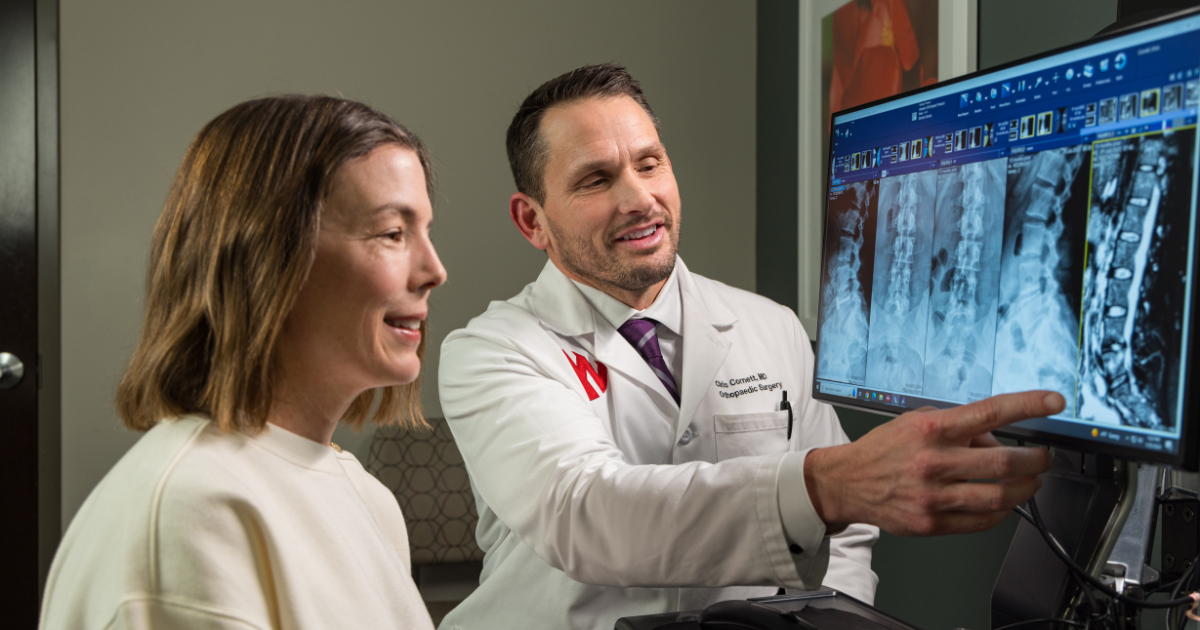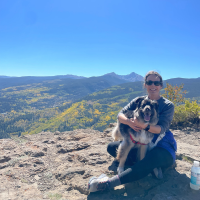Spine surgery transforms pain and perspective

Karen Linnell, a physical therapist with 30 years of experience, found herself in a challenging battle between chronic back pain and fears about spine surgery. Today, she is pain-free and enjoying life, but it was a long road to diagnosis, surgery and recovery.
Decades of pain

Linnell first experienced back pain when she was pregnant with her first child 28 years ago. Initially intermittent, the pain gradually intensified, hindering her daily life.
As a physical therapist, Linnell tried various exercises and stretches to alleviate her discomfort but found little relief. When she was 50, the pain became a significant problem, leaving her unable to sit for extended periods of time.
“In August 2020, I went on a trip to Colorado, and that is the last time I remember being able to sit and not be in pain,” she says. “After that, my sitting tolerance just got worse and worse.”
Medical intervention
Determined to find a solution, Linnell worked with a physical therapist friend. Despite their efforts, her relief was minimal.
Frustrated, Linnell consulted orthopaedic surgeon Chris A. Cornett, MD, for a comprehensive evaluation. An MRI showed Linnell had arthritis in the L4 and L5 vertebrae of her lower back, and Dr. Cornett felt she was a good candidate for an anterior lumbar fusion.
“She had back pain that was limiting the quality of her life,” Dr. Cornett says. “Her arthritis, or disease process, was pretty focal at one level, as opposed to being spread out, so surgery had a high chance of success.”
Falling into a camp of physical therapists who prefer nonsurgical approaches, Linnell was hesitant. With a physical therapy background of his own and an overall conservative approach to surgery, Dr. Cornett was understanding. He suggested Linnell wait six months and see how her pain was.
Seeking an alternative
Hoping to find a noninvasive solution, Linnell explored alternatives as her pain grew even worse.
“I would have spasms so bad that they made me buckle and collapse to the floor,” she says. “So, I made another appointment with Dr. Cornett, and he showed me how, if you looked at my back from the right side, it looked amazing. But if you looked at the left side, the facet joints were collapsing and pushing into the disc material.”
But Linnell was still uncertain about surgery. She tried additional physical therapy to no avail. Her pain was becoming debilitating, so she scheduled the surgery, but rising COVID-19 cases led to a delay.
The surgery
Finally, in July 2022, Dr. Cornett performed Linnell’s procedure, which involved accessing the spine from the front of her body, through an incision in her belly. Vascular surgeon G. Matthew Longo, MD, joined Dr. Cornett to clear a path to the spine, mobilizing the blood vessels in the area.
While most back surgeries are performed through incisions in the back, Dr. Cornett thought Linnell’s case lent itself well to an anterior approach.
“Since we were treating Karen for back pain, our goal was to stabilize that one disc,” Dr. Cornett says. “It’s nice to do that surgery from the front because we don’t cut any muscle. It doesn’t structurally change your spine a lot other than stabilizing that one segment.”
The surgery was successful, but Linnell experienced normal postoperative pain, leading to moments of doubt.
“Even though I had lectured patients about surgical pain and Dr. Cornett had forewarned me, I thought, ‘I did the wrong thing – I’m never going to be able to work again,’” she says.
The road to recovery
Motivated to regain her strength, Linnell followed her recovery plan, taking regular walks around her neighborhood.
Around the eight-week mark, she started to notice significant improvement, gradually reducing her reliance on pain medication. By October, Linnell was well on her way to a full recovery and returned to work. Since then, she has resumed the activities she loves, like hiking, and lives without back pain.
Linnell’s experience has profoundly impacted her perspective as a physical therapist. She now recognizes spine surgery’s potential benefits and offers advice to those who might feel the same hesitancy she did.
“If you’re approaching back surgery, it’s OK to be afraid,” she says. “You just have to find someone you trust, who will listen to your concerns and be supportive and encouraging, like Dr. Cornett was to me.”
Don't let it interfere with the activities you love. Schedule an appointment with one of our spine providers at NebraskaMed.com/Spine.







